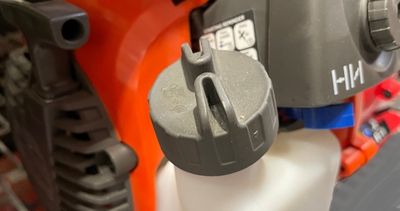It’s up to the owner to maintain their leaf blower to keep it running at its best and extend its useful life. This includes choosing the right type of fuel and storing it properly to reduce fuel-related issues.
A Husqvarna leaf blower with a 2-cycle engine requires a 50:1 gas and oil mixture. Mix a premium two-cycle engine oil that is ISO-L-EGD and JASO M345 FD certified with unleaded gasoline that has a maximum 10% ethanol content and a minimum 89 octane rating.
Take precautions when working with fuel including working in a well-ventilated area and wearing safety glasses. The fuel tank may become pressurized. Wait for the engine to cool down and slowly loosen the cap. If you hear a lot of pressure, tighten the cap and wait a little longer before removing it.

Old Gas in a Husqvarna Leaf Blower
Chances are you’ve allowed old fuel to sit in your equipment for long periods of time. I’ve done that. It’s hard to know exactly how often a leaf blower will be used and how much fuel will be consumed.
Using old gas in your leaf blower can result in starting and running problems. It can lead to fuel restrictions and parts failures including the carburetor.
Gas can begin to break down as quickly as 30 days after purchase. It’s important to consume fuel within this timeframe.
However, as I said before, it can be hard to know just how much fuel you are going to go through in 30 days. Because of this, I add a fuel stabilizer to make gas last a little longer before it breaks down.
Some 2-cycle oils include a fuel stabilizer. Don’t assume the stabilizer will last longer than 30 days unless the information is provided by the manufacturer. Some stabilizers will last up to 30 days while others can last up to two years.
Most types of gasoline on the market today contain ethanol, an alternative fuel added to make fuel more environmentally friendly. Ethanol is not good for a small engine like the one on your leaf blower.
Ethanol naturally attracts moisture from the air which causes corrosion and gumming of the fuel system. Never use gasoline that has an ethanol content greater than 10%. The lower the ethanol content the better.
Gas and Oil Mix to Use in a 2-Cycle Husqvarna Leaf blower
Don’t make the mistake of adding straight gas in a 2-cycle Husqvarna leaf blower or you may end up having to buy a new leaf blower.
Straight gas runs very dry and will cause the engine to seize and quit. Without oil added to the gas, the engine doesn’t get the lubrication it requires for internal parts to move freely.
A Husqvarna blower engine will have one fill port for an oil and gas fuel mixture. Husqvarna 2-cycle equipment requires a fuel consisting of a gas-to-oil mixture at a rate of 50:1: This means 50 parts gas is mixed with 1 part oil.
When creating this mix, use unleaded gasoline with a minimum octane rating of 89 (mid-grade) and maximum ethanol content of 10%. Add a 2-cycle premium oil that is ISO-L-EGD and JASO M345 FD certified.
How to Mix Gas and Oil for a 2-Cycle Husqvarna Blower:
- Use the chart below to determine how much fuel mix to prepare.
- Remove the cap from an approved gas can. Add unleaded fuel (minimum 89 octane rating & maximum 10% ethanol content) to a gas can.
- Using the chart for ounces of oil required, add the 2-cycle oil to the gas can.
- Replace the cap.
- Gently shake the fuel and oil until they are mixed.
- Add to your Husqvarna’s leaf fuel tank.
You can use the Husqvarna XP 2-cycle oil. Another alternative is this 2-cycle mix by Kawasaki. It comes in 5.2 oz. and 6.4 oz. bottles that can be mixed with 2 gal. or 2.5 gal. of gas respectively for a 50:1 mix.
2-Cycle Gas to Oil Mix Ration for Husqvarna Leaf Blowers
| Gas to Oil Mix | 1 Gallon | 2 Gallon | 2.5 Gallon |
|---|---|---|---|
| 50:1 | 2.6 oz | 5.2 oz | 6.4 oz |
Using Ethanol-Free Fuel is Best for a Husqvarna Leaf Blower
To avoid the negative effects caused by using an ethanol-based fuel, it’s best to use an ethanol-free fuel in a Husqvarna blower. This is the more costly option for fueling your blower.
Husqvarna offers a premixed fuel ready to pour into the fuel tank. This is not only a great option for the blower, but it’s also a very convenient option for the user.
I love having fuel ready to use whenever I need it. There’s no more running to the fuel station to fill up on gas or the mess involved when mixing the fuel. I just keep a couple of cans of premixed fuel on the shelf.
